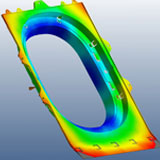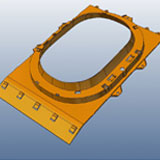

 High temperature plastics for Airbus
High temperature plastics for Airbus
The aerospace industry makes high demands on its suppliers and DEVA-Kunststoff-Technik GmbH is a proven partner in this sector. Using the CAD/CAM solution developed by Vero Software, this Lemgo company produces several hundred different injection-moulded parts for all civil Airbus models as well as for the military transport plane A400M and the Eurofighter.
Every gramme of weight saved is important to the aerospace industry. However, for safety reasons, nearly all plastic parts within an aeroplane must comply with the high stability and temperature requirements of the aircraft industry. For this reason, only high-temperature plastics such as Ultem, Radel, Victrex Peek, Teflon, etc. are used for such parts. DEVA-Kunststoff-Technik GmbH specialises in the manufacture of products made of high-temperature plastics, and produces them using mould tools made of fully hardened steel and injection moulding machines that have clamping forces between 30 to 650 tonnes. The weight of the products range from 0.6 to 1700g with a mostly automated production process using robots and handling devices.
"The excellent integration of surface and solid functions is a further advantage of VISI. If we get stuck at a point during the model construction, we are able to move from the solid model back to the surface model without any problems.”
Nils Waterboer, Project Manager
In total, DEVA-Kunststoff-Technik have six milling machines with a maximum traverse path of 1200mm - including a 5-axis processing centre and two high-speed milling machines - as well as wire-based and vertical eroding machines. The design of the tools are handled internally by three designers, who use the VISI Modelling, VISI Mould, VISI Analysis and VISI Electrode applications. For toolpath creation, VISI Machining 3D and VISI 5 Axis are used. During the test phase, VISI Flow is used to simulate the plastic flow front during the injection moulding process. VISI has CAD interfaces to support all major data formats such as CATIA, UG, Pro E, Parasolid, IGES, STEP, SolidWorks, Solid Edge, VDA and SAT. The extensive range of translators ensure that DEVA can work with data from almost any supplier. The strength of the CAD/CAM solution is the hybrid modeller, which offers solid and surface structures as well as a completely integrated information flow from CAD to CAM and vice versa.
DEVA receives their customer data in CATIA format and imports the file directly into VISI using the native CATIA interface. Project manager Nils Waterboer stated that “excellent handling of third-party data was one of the reasons for selecting VISI after a comparison with other CAD programs. Internally, the data is administrated onto a central server which requires specific access rights.” After the data has been imported and validated, Nils and his colleagues use VISI Mould to create the basic design of the 3D tool, including the ejector and cooling system.
VISI Analysis has proved to be an invaluable tool for DEVA as they use the automatic model separation to test whether possible tool parting conditions are feasible. If problems are detected, designers can work jointly with the customer to modify the product until it complies with the required characteristics, as well as with production requirements. Increasingly, customers no longer design their own products but only provide the specifications. The product is then developed and designed by DEVA. The integration of the VISI modules makes it possible to check and consider the effect of model changes on the 3D tool at any time. According to Nils Waterboer, “the excellent integration of surface and solid functions is a further advantage of VISI. If we get stuck at a point during the model construction, we are able to move from the solid model back to the surface model without any problems. This can be rather difficult and dangerous with other CAD programs.”
Once the design of the product has been completed, a single cavity prototype tool is built, depending on the customer specifications. Inserts are installed into a master tool so that the first prototypes injection moulding tests can be performed without delay. They are then tested by the customer or at DEVA. If changes are required, the designer revises the design in VISI and the inserts are changed in preparation for re-testing.
VISI has been a complete success at DEVA-Kunststoff-Technik. Practical experience with other CAD programs has shown that the VISI software learning curve is short due to the consistent user interface for all VISI modules. DEVA considers the programming for 5-axis simultaneous milling as a particularly good solution, as existing 3-axis programs can be converted to 5-axis programs with little effort.
DEVA has recently purchased VISI Flow to increase process safety. The module can be used for plastic filling simulations and product distortion. It contains parameters relating to the behaviour of different plastics, based on experience gathered over several years. The simulation therefore shows where weld lines might form, whether the venting works correctly and whether there will be product distortion. Production manager Matthias Spilling expects practical benefits from the new VISI application: “Parameters for the special plastics used in the aircraft industry that are not yet stored in VISI Flow, are captured with an input frame. We fully expect this new module to save us considerable time during the product testing phase.”
About The Company:
Name: DEVA-Kunststoff-Technik GmbH
Web: www.deva-lemgo.de
Benefits Achieved:
- Excellent CAD interfaces supporting all major data formats
- VISI Flow for plastic flow front simulation, prior to tool design
- Powerful CAD tools to manipulate complex customer data and apply design changes
"The excellent integration of surface and solid functions is a further advantage of VISI. If we get stuck at a point during the model construction, we are able to move from the solid model back to the surface model without any problems.”
Nils Waterboer
Project Manager







